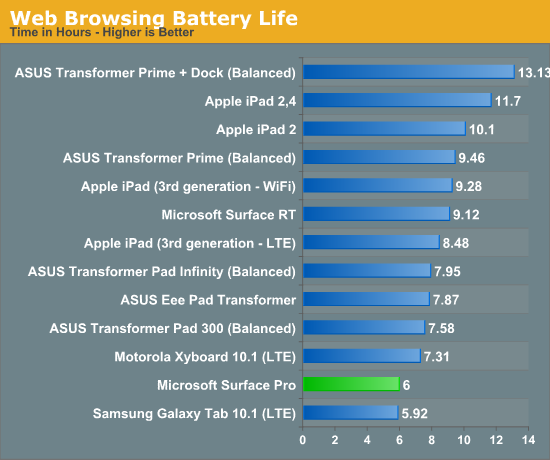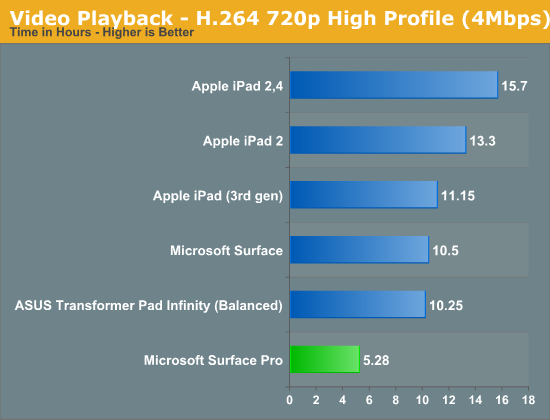Microsoft Surface Pro Review
by Anand Lal Shimpi on February 5, 2013 9:00 PM ESTBattery Life: The Downside
Despite having an integrated 42 Wh battery (similar in size to the 3rd and 4th gen iPads with Retina Display), battery life is a real sore spot for Surface Pro. Haswell is really designed to drive platform power down to very low levels, which should help close the gap between ARM/Atom based tablets and Core based tablets. Unfortunately, Haswell for tablets won’t hit until the third quarter of this year, which forced Microsoft to use Ivy Bridge.
In our tablet benchmarks, I never saw Surface Pro break the 6 hour mark on a single charge. In most cases I’d expect to see 5 - 6 hours out of Surface Pro in light, tablet usage. Video playback was especially disappointing as Surface Pro managed to use more power here than during our web browsing battery life test. I suspect this might have to do with the relative power efficiency of Ivy Bridge's video decoder. It'll be interesting to see how Haswell does in this department.


I also put Surface Pro through some of our new notebook battery life tests for 2013, and here it didn’t fare too bad. I only have Acer’s 13-inch S7 to compare to but Microsoft managed 3.85 hours in our medium workload compared to sub-3 hours for the larger Ultrabook:
| Windows 8 Notebook Battery Tests | ||
| Battery Test | Acer Aspire S7 (13-inch) | Microsoft Surface Pro |
| AnandTech 2013 Light | 4.00 hours | 5.2 hours |
| AnandTech 2013 Medium | 2.88 hours | 3.85 hours |
This is easily the biggest disappointment with Surface Pro. You just won’t get the all day battery life you do with an ARM based tablet out of this design. I expect Microsoft will have a solution to this problem with Haswell, but not until the end of the year.
Charging
Surface Pro retains the same large, magnetic power connector as Surface RT. In fact, Surface RT’s power adapter will still charge Surface Pro. The Pro model does however come with its own 48W adapter. It’s a nice looking, but large and still fairly traditional two piece power supply (brick + detachable wall cable). There’s no sophisticated cable management other than a tiny hook to help keep the device end of the cable together. One neat feature is the power adapter does feature an integrated USB port for charging your smartphone.
Under max charging load the power supply will draw around 27W at the wall. Microsoft included a 48W unit in order to be able to charge and power the device without slowing down charge time. It took me 2.692 hours to charge Surface Pro from completely empty to 100% with no additional power draw at the wall. The quick charge time is pretty nice and about the only reprieve here when talking about Surface Pro's battery.
I did notice something odd with the first power supply Microsoft sent me. When charging through my power meter, I picked up some interference in the capacitive touch screen itself resulting in around 10% of my taps not being recognized. Microsoft supplied another power supply that seemed to resolve the issue.













228 Comments
View All Comments
ghost03 - Monday, February 11, 2013 - link
Most of what you say is accurate, but I disagree that this can be compared to the MacBook Air (or any ultra book for that matter.)A key feature of laptops is that they function on your ...lap... (or other surfaces which are not flat or angled.) Juggling the kickstand and the hinged keyboard is cumbersome at best for most non ideal use scenarios. And frankly, if I am set up with a flat table and room to work, I hope I have my 15" notebook with me.
This is an attempt to satisfy too many interests--likely a victim of design by committee--and it is not a product that I can see many people enjoy using.
utdcometsoccer - Tuesday, March 19, 2013 - link
I've used it some and I found it was a joy to work with! Also, strangely the dual use design - tablet and laptop suits me because I don't want to carry a tablet and a laptop if I don't have to.rburnham - Wednesday, February 6, 2013 - link
Agreed. Seeing it compared to ARM tablets seems unfair in the context of this article.GotThumbs - Thursday, February 7, 2013 - link
Agreed. It's basically the upgrade from the Tablet PC's before the IPAD was born. I still have a Motion Tablet PC (LS800) in my office and the only reason I don't have Win8 installed on it is the screen resolution limit. The Motion Tablet PC resolution is a very small/old 800 x 600.I like the fact that Anand did a dual comparison between today's tablets and ultra-books for the Surface-pro. Regarding the issues on lap use, I believe the addition of a keyboard dock similar tot he transformer would allow the Surface to convert between being a tablet and ultra book when the user needed/wanted.
All in all, I think MS has a good start. Now with newer/smaller CPU's from Intel or AMD (if they can get their die smaller) will allow MS to be even more competitive.
At the end of the day, each consumer has to figure/know what their needs are to select the right tool for them. Tablets are great for content, but still very limited to APPs. A tablet that can run full programs for those needing that kind of flexibility stands above Android and IOS devices.
AssBall - Tuesday, February 5, 2013 - link
Possibly a little more in depth than need be for the target demographic.AssBall - Tuesday, February 5, 2013 - link
On second thought though, that's exactly the kind of info that makes the target market drool.PsychoPif - Wednesday, February 6, 2013 - link
It's exactly for those kind of insight that I come here. If I wanted an half assed job, I'd read the engadget review.Spunjji - Friday, February 8, 2013 - link
Right on.mmrezaie - Friday, February 8, 2013 - link
but I still like to know gpu comparison between this and iPad 4.B3an - Wednesday, February 6, 2013 - link
Stupid comment is stupid. Go back to Engadget or the Verge.